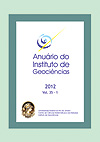The contribution of Museology to the diffusion of the geological heritage of the National Park of Tijuca
DOI:
https://doi.org/10.11137/2012_1_68_79Abstract
In addition to its amazing biodiversity, the National Park of Tijuca (PARNA-Tijuca) represents a parcel of territory characterized by its geodiversity - clearly noticed on the rough landscape that allows the maintenance of diverse life forms. The presence of Augen gneiss is responsible for unique morphological aspects such as pontoons, steep cliffs, peaks and other forms of relief that defined, through history, specific forms of land occupation and use, becoming symbols of Rio de Janeiro. This paper emphasizes the importance of preserving the geological heritage in the area of the National Park of Tijuca. The work of museums in relation to geological heritage highlights the importance of this landscape as a powerful representation of the evolution of Planet Earth, of the city of Rio de Janeiro and of Brazil - based on an ethical proposal of building the future through the transformation of the present, and which includes to think and to work on the representation of heritage as an asset for public use. It is the aim of Museology to legitimate such work, assuring the use of adequate processes of documentation, research, preservation and dissemination of knowledge on the preserved heritage.Downloads
Download data is not yet available.
Downloads
Published
2012-06-01
How to Cite
Beliani, E. and Scheiner, T. (2012) “The contribution of Museology to the diffusion of the geological heritage of the National Park of Tijuca”, Anuário do Instituto de Geociências. Rio de Janeiro, BR, 35(1), pp. 68–79. doi: 10.11137/2012_1_68_79.
Issue
Section
não definida
License
This journal is licensed under a Creative Commons — Attribution 4.0 International — CC BY 4.0, which permits use, distribution and reproduction in any medium, provided the original work is properly cited.















